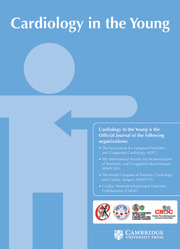No CrossRef data available.
Article contents
An intervention in the paediatric cardiac ICU to standardise pre-family meeting huddles is feasible, acceptable, and improves clinician teamwork
Published online by Cambridge University Press: 07 February 2025
Abstract
Interprofessional teams in the pediatric cardiac ICU consolidate their management plans in pre-family meeting huddles, a process that affects the course of family meetings but often lacks optimal communication and teamwork.
Cardiac ICU clinicians participated in an interprofessional intervention to improve how they prepared for and conducted family meetings. We conducted a pretest–posttest study with clinicians participating in huddles before family meetings. We assessed feasibility of clinician enrollment, assessed clinician perception of acceptability of the intervention via questionnaire and semi-structured interviews, and impact on team performance using a validated tool. Wilcoxon rank sum test assessed intervention impact on team performance at meeting level comparing pre- and post-intervention data.
Totally, 24 clinicians enrolled in the intervention (92% retention) with 100% completion of training. All participants recommend cardiac ICU Teams and Loved ones Communicating to others and 96% believe it improved their participation in family meetings. We exceeded an acceptable level of protocol fidelity (>75%). Team performance was significantly (p < 0.001) higher in post-intervention huddles (n = 30) than in pre-intervention (n = 28) in all domains. Median comparisons: Team structure [2 vs. 5], Leadership [3 vs. 5], Situation Monitoring [3 vs. 5], Mutual Support [ 3 vs. 5], and Communication [3 vs. 5].
Implementing an interprofessional team intervention to improve team performance in pre-family meeting huddles is feasible, acceptable, and improves team function. Future research should further assess impact on clinicians, patients, and families.
- Type
- Original Article
- Information
- Copyright
- © The Author(s), 2025. Published by Cambridge University Press



